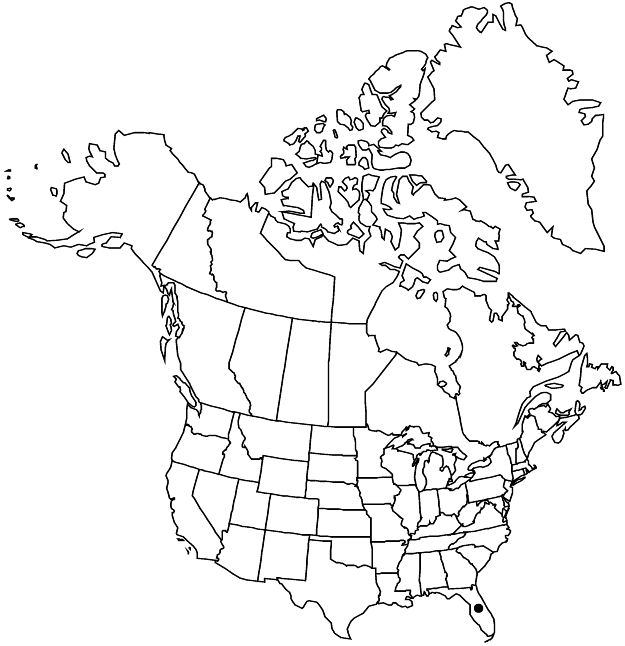Difference between revisions of "Hibiscus acetosella"
Cat. Afr. Pl. 1: 73. 1896.
FNA>Volume Importer |
imported>Volume Importer |
||
| Line 28: | Line 28: | ||
|elevation=0–20 m | |elevation=0–20 m | ||
|distribution=Fla.;Africa;introduced also in Mexico;West Indies;Central America;South America;Asia (Indonesia). | |distribution=Fla.;Africa;introduced also in Mexico;West Indies;Central America;South America;Asia (Indonesia). | ||
| + | |introduced=true | ||
|discussion=<p><i>Hibiscus acetosella</i> is cultivated as an ornamental and as a salad plant and occasionally escapes. It apparently originated in Africa, perhaps as an amphidiploidized hybrid between H. asper Hooker f. and H. surattensis Linnaeus (M. Y. Menzel 1986) and may no longer exist there or anywhere else truly in the wild (F. D. Wilson 1994).</p> | |discussion=<p><i>Hibiscus acetosella</i> is cultivated as an ornamental and as a salad plant and occasionally escapes. It apparently originated in Africa, perhaps as an amphidiploidized hybrid between H. asper Hooker f. and H. surattensis Linnaeus (M. Y. Menzel 1986) and may no longer exist there or anywhere else truly in the wild (F. D. Wilson 1994).</p> | ||
|tables= | |tables= | ||
| Line 52: | Line 53: | ||
|publication year=1896 | |publication year=1896 | ||
|special status=Introduced | |special status=Introduced | ||
| − | |source xml=https:// | + | |source xml=https://bibilujan@bitbucket.org/aafc-mbb/fna-data-curation.git/src/bb6b7e3a7de7d3b7888a1ad48c7fd8f5c722d8d6/coarse_grained_fna_xml/V6/V6_468.xml |
|subfamily=Malvaceae subfam. Malvoideae | |subfamily=Malvaceae subfam. Malvoideae | ||
|genus=Hibiscus | |genus=Hibiscus | ||
Revision as of 23:40, 27 May 2020
Subshrubs, 1–2(–4) m, herbage usually dark red throughout, glabrous, rarely sparsely hairy. Stems with line of fine, curved hairs. Leaves: stipules linear-lanceolate, (8–)10–15 mm; petiole 1/2 to ± equaling blade, with fine, curved hairs adaxially; blade usually dark red, broadly to transversely ovate, usually deeply 3–5-lobed, 4–10 × 3.5–10 cm, base broadly cuneate to truncate, margins crenate or crenate-serrate, apex acute to acuminate, lobes narrowly elliptic or narrowly obovate, surfaces glabrate, prominent slitlike nectary present abaxially on midvein near base. Inflorescences solitary flowers in axils of distal leaves, sometimes together appearing racemose by reduction of subtending leaves. Pedicels jointed near middle, to 1.2 cm; involucellar bractlets 8–10, terete, 0.6–1.6 cm, margins setose, apices 2-fid or appendaged. Flowers horizontal; calyx divided nearly 2/3 length, funnelform-campanulate, 1.2–2 cm, lobes triangular, with 3 prominent ribs, 2 marginal, 1 medial, medial bearing nectary, apices acuminate, veins setose with pustular-based, simple hairs; corolla funnelform-rotate, petals cream, yellow, or dull pink to dull red with veins usually darker pink, maroon basally, asymmetrically obovate, 3–5.5 × 2.5–4.5 cm, margins repand, finely hairy abaxially where exposed in bud; staminal column straight, maroon, 1.5–2.5 cm, bearing filaments nearly throughout, free portion of filaments not secund, 1.5–2.5 mm; pollen yellow; styles maroon, to 1 mm; stigmas maroon. Capsules reddish brown, ovoid, 1.6–2.5 cm, apex acute or short-acuminate, weakly antrorsely hispid with simple, scattered, loose hairs. Seeds olivaceous brown, angulately reniform-ovoid, 3.5–4 mm, papillose-scaly, scales pectinate. 2n = 72.
Phenology: Flowering mostly fall–winter.
Habitat: Roadsides, disturbed areas
Elevation: 0–20 m
Distribution

Introduced; Fla., Africa, introduced also in Mexico, West Indies, Central America, South America, Asia (Indonesia).
Discussion
Hibiscus acetosella is cultivated as an ornamental and as a salad plant and occasionally escapes. It apparently originated in Africa, perhaps as an amphidiploidized hybrid between H. asper Hooker f. and H. surattensis Linnaeus (M. Y. Menzel 1986) and may no longer exist there or anywhere else truly in the wild (F. D. Wilson 1994).
Selected References
None.